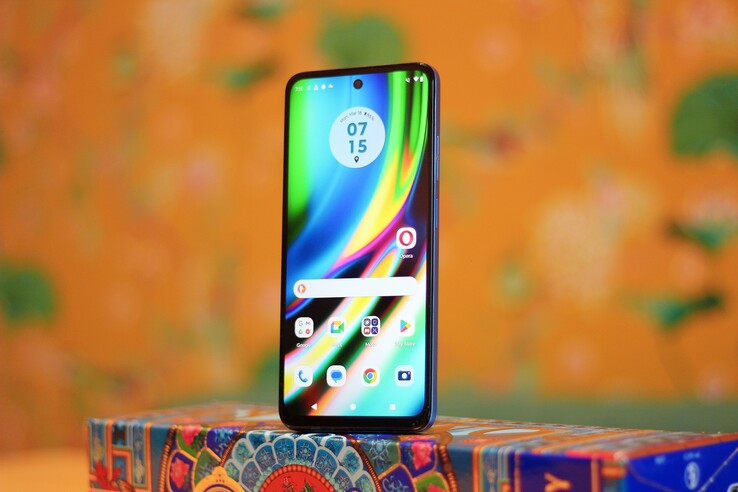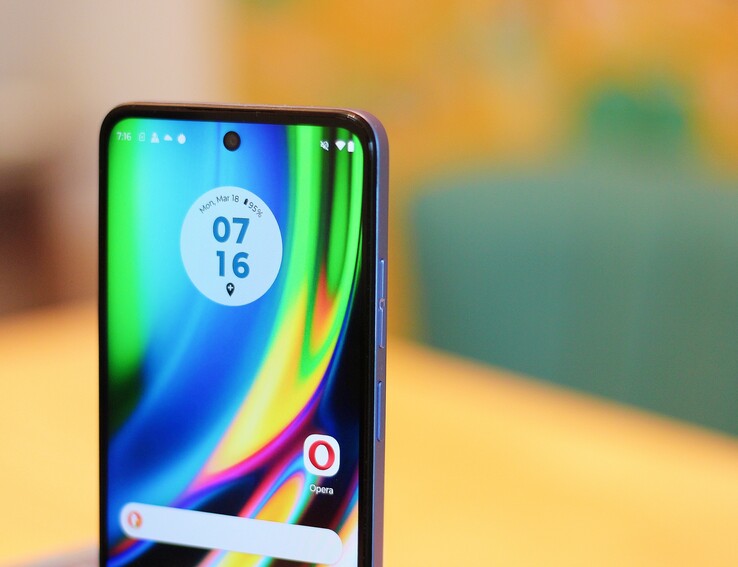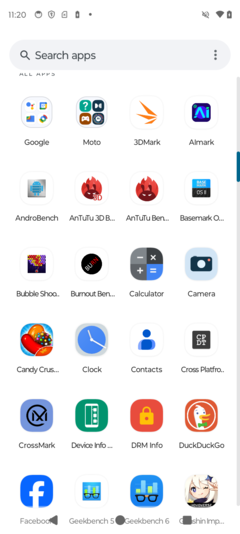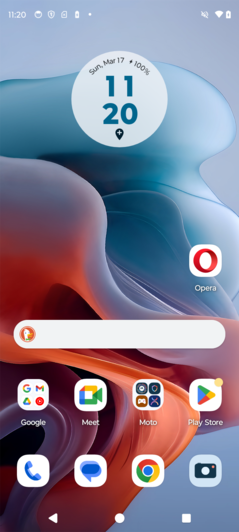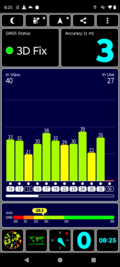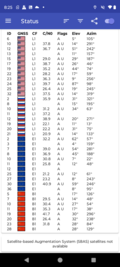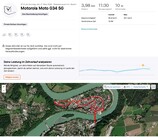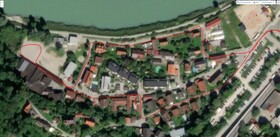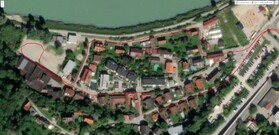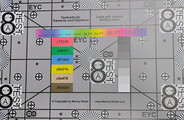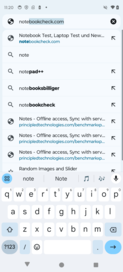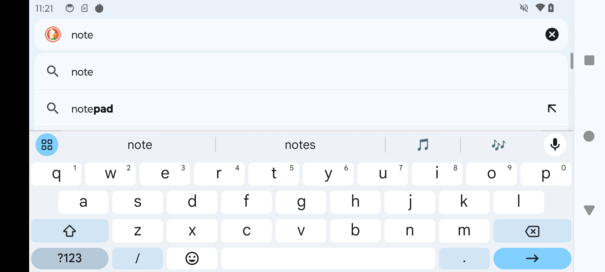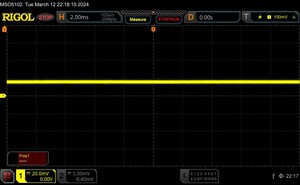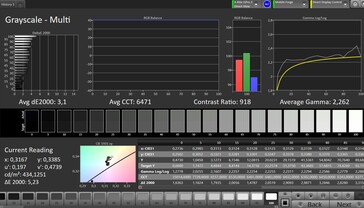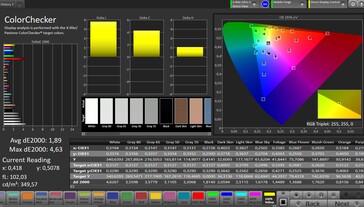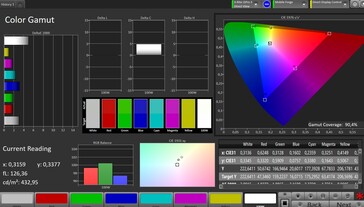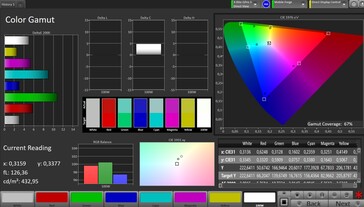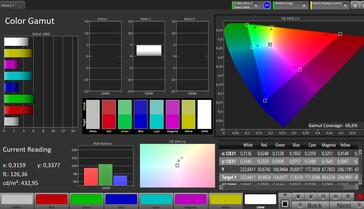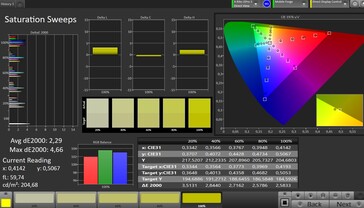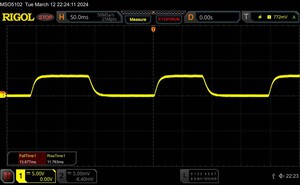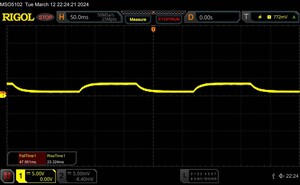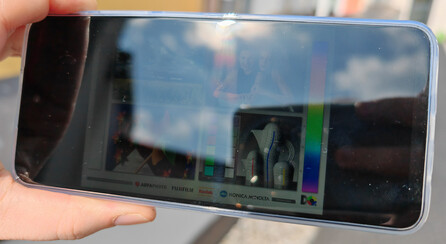Motorola Moto G34 5G smartphone review – The phone for money-savers who don't want to do without
The mid-range Moto-G series smartphones are super popular—and no wonder, as Motorola has given its devices nearly unchanged stock Android for years, plus, its phones boast great connectivity for a good price.
The Motorola Moto G34 5G retails for around US$220 and still, you don't have to go without modern connectivity options.
In this review, we will be taking a closer look at whether the Motorola phone is the best choice, as the competition within this price range is strong and plentiful.
Possible competitors compared
Rating | Date | Model | Weight | Drive | Size | Resolution | Price |
|---|---|---|---|---|---|---|---|
| 81.9 % v7 (old) | 03 / 2024 | Motorola Moto G34 SD 695 5G, Adreno 619 | 179 g | 128 GB UFS 2.1 Flash | 6.50" | 1600x720 | |
| 79 % v7 (old) | 03 / 2023 | Motorola Moto G23 Helio G85, Mali-G52 MP2 | 184.3 g | 128 GB eMMC Flash | 6.50" | 1600x720 | |
| 80.2 % v7 (old) | 02 / 2024 | Xiaomi Redmi Note 13 4G SD 685, Adreno 610 | 188.5 g | 128 GB UFS 2.2 Flash | 6.67" | 2400x1080 | |
| 75.9 % v7 (old) | 07 / 2023 | Samsung Galaxy A14 LTE Helio G80, Mali-G52 MP2 | 201 g | 64 GB eMMC Flash | 6.60" | 2408x1080 | |
| 74.6 % v7 (old) | 07 / 2023 | Honor X7a Helio G37, PowerVR GE8320 | 196 g | 128 GB eMMC Flash | 6.74" | 1600x720 |
Case – Design leaves more to be desired
The affordable Motorola smartphone comes in three color variants: Ocean Green (a dark green with a blue tint), Ice Blue (a light pastel blue) and Charcoal Black (which is just black). In all color versions, the back is made from matte plastic that shimmers ever so slightly in the light.
The camera module stands out in terms of materials and color, bulging out of the back like a cushion. It appears more like a foreign object and as a result, we see it as less of a success from a design standpoint.
The bezels around the screen on the front are clearly visible but for the price range, they are still a normal size.
In terms of footprint and weight, the Motorola phone proves to be compact and relatively light, however, at 6.5 inches, its display is a little smaller than most of the competitors. If you grab the phone slightly more tightly, it sometimes creaks but in total, it is built very solidly.
Connectivity – Lots on offer
In Europe, where we carried out this test, there is only one storage variant of the Moto G34 5G available, namely with 128 GB storage and 4 GB RAM. According to the manufacturer, it costs US$220, but you can already find it cheaper online.
Buyers can look forward to good connectivity including NFC, a 3.5-mm audio jack, stereo speakers and even eSIM support. In turn, you'll have to make do with only one nano SIM card slot.
The ability to connect to the 5G network is a rarity for a price of around US$200, but the Motorola Moto G34 5G offers exactly that.
microSD card reader
The microSD card slot is situated next to the SIM card slot and it can accommodate cards up to 1 TB in size. Its read and write speeds are decent for the price class, but they couldn't fully take advantage of our Angelbird V60 reference card's possible data rates.
| SD Card Reader - average JPG Copy Test (av. of 3 runs) | |
| Samsung Galaxy A14 LTE (Angelbird AV Pro V60) | |
| Motorola Moto G34 (Angelbird V60) | |
| Honor X7a (Angelbird V60) | |
| Xiaomi Redmi Note 13 4G (Angelbird V60) | |
| Motorola Moto G23 (Angelbird V60) | |
Cross Platform Disk Test (CPDT)
Software – Stock Android with 3 years of updates
Motorola has installed Android 14 on the phone and hasn't changed much about Google's operating system. Settings for functions specific to this smartphone are stored within the Moto app, so the regular settings menu doesn't appear overcrowded.
Our test device's latest security patch was from February 2024 so at the time of testing, this was pretty up-to-date. Motorola has had its smartphone included in the "Android Enterprise Recommended" program and must therefore make an update promise: Security patches every two months until January 2027 and, in any case, Android 15 as an update.
Unfortunately, the phone comes with quite a few sponsored apps and games pre-installed, but they can all easily be deleted.
Communication and GNSS – The 5G smartphone for little money
The Wi-Fi modem supports Wi-Fi 5 as its fastest standard. This is common within this price range and the Motorola Moto G34 5G achieves typical speeds for a smartphone costing around US$220. However, slight fluctuations in its data rate during transmission were visible in our test. Unfortunately, they also occurred from time to time when we repeated the test.
Close to the router, the phone still loads web pages quite quickly and it shows full reception bars. At a distance of 10 meters from the router and with 3 walls in between, the reception indicator still shows 3/4 of the signal strength, which means that it takes considerably longer to load pages.
The Motorola Moto G34 is a 5G smartphone, so you can also use the fastest current mobile communications standard. Sufficient 4G and 5G frequencies are available in Europe, which is where we tested the phone. However, if you are planning a trip, you should check in advance whether the Moto G34 5G also supports the necessary bands—it is by no means a world phone that can be used everywhere.
| Networking | |
| Motorola Moto G34 | |
| iperf3 receive AXE11000 | |
| iperf3 transmit AXE11000 | |
| Motorola Moto G23 | |
| iperf3 receive AXE11000 | |
| iperf3 transmit AXE11000 | |
| Xiaomi Redmi Note 13 4G | |
| iperf3 receive AXE11000 | |
| iperf3 transmit AXE11000 | |
| Samsung Galaxy A14 LTE | |
| iperf3 receive AXE11000 | |
| iperf3 transmit AXE11000 | |
| Honor X7a | |
| iperf3 receive AXE11000 | |
| iperf3 transmit AXE11000 | |
| Average of class Smartphone | |
| iperf3 receive AXE11000 | |
| iperf3 transmit AXE11000 | |
We tested the Moto G34 5G's locating accuracy by stepping outside. We were then located quite quickly with an accuracy of 3 metres. However, as it doesn't support SBAS for even more precise locating, this is the standard result.
In order to test how well the Motorola smartphone's locating module works in practical use, we took a trip on our bike using the Garmin Venu 2 smartwatch as a comparison device.
All-in-all, the Moto G34 5G delivered pretty accurate results; it only deviated by a few metres now and again. This became especially visible when cycling through narrow city alleyways.
Even so, you can use the phone for navigation purposes without any issues. Only if you seek absolute precision should you probably look elsewhere.
Telephone features and call quality – Nice and clear
Motorola uses the telephone app from Google, the same one that can be found on a lot of other Android smartphones. It is structured clearly and offers all the required features, such as caller lists and quick access to your saved contacts.
Its call quality with the phone held up to your ear is decent, the sound isn't distorted at maximum volume and you always hear the person on the other end of the line clearly. Our voice was also transmitted well, however, we just had to make sure to not speak too quietly, otherwise the microphone didn't pick anything up.
The person on the other end of the line can be understood well using the phone's loudspeaker, too. The hands-free microphone proved to be a little less accurate, as it seems to record quiet voices with a lot of interruptions. Furthermore, you should make sure to speak in the direction of the microphone, otherwise the call won't be as clear.
Cameras – Breaking class boundaries
The main camera on the back has a maximum resolution of 50 megapixels, however, it usually takes 12.5-MP photos. The photo module combines four image points into one large pixel, resulting in photos with a higher light yield.
Moreover, the phone's back houses a macro lens which can be used for extreme close-up shots, however, at 2 MP, it doesn't have the highest resolution. The device doesn't feature an ultra-wide-angle lens. The competition has an advantage in this aspect: The Samsung Galaxy A14 LTE and Redmi Note 13 4G both have such a lens.
Even so, photos taken on the Moto G34's main camera are pretty good when you consider it costs less than US$250: It depicts colors vividly and in the landscape image, the clouds in the sky were shown with great detail without appearing washed out. Still, its level of detail can't compete with that of more expensive phones.
We like how the photos are lightened in darker surroundings. Again, high-end devices will of course offer even better results at times but with regard to its price, it is impressive how much the Moto G34 can manage. If anything, its sharpness could just do with being better.
Videos can be recorded at a maximum of 1080p and 30fps. Its picture quality is fine, the camera's autofocus and automatic brightness adjustment work fast and almost imperceptibly.
The front-facing camera has a 16-megapixel resolution and takes good selfies in daylight. You shouldn't expect too many details in darker areas of the photos, but their sharpness is good and if needed, you can enlarge them without losing too much quality.
Image comparison
Choose a scene and navigate within the first image. One click changes the position on touchscreens. One click on the zoomed-in image opens the original in a new window. The first image shows the scaled photograph of the test device.
Main camera plantMain camera landscapeMain camera low lightThe main camera had to undergo a second test in our test lab using precisely regulated lighting situations. The test chart was depicted quite sharply and reasonably in high-contrast in very good lighting, although the colors were a little too bright. The details of the test chart could still be recognized to some extent at only 1 lux illumination.
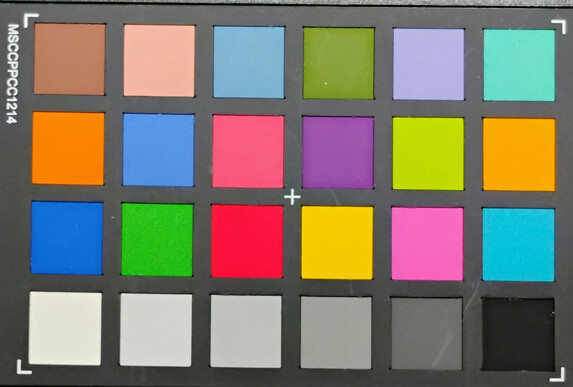
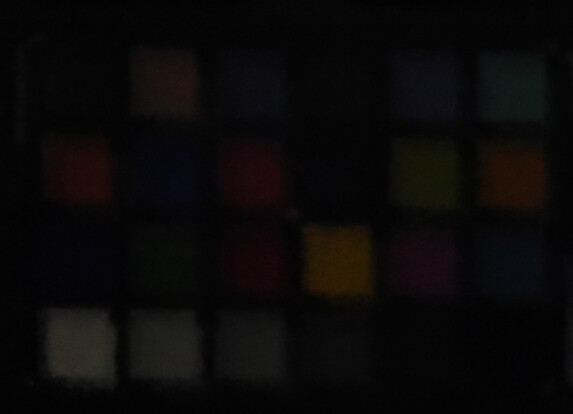
Accessories and warranty – Lots included with the phone
Bucking the trend, Motorola has decided to include a charger with its affordable smartphone, which, at up to 20 watts, even manages a little more than the Moto G34's maximum possible charging power (specified at 18 watts). Of course, a suitable USB cable is also included. The phone is also protected by a silicone cover.
If needed, you can buy a replacement charger from Motorola's Amazon store.
For warranty information, we would recommend taking a look at your local laws.
Input devices & operation – Fast display and great fingerprint sensor
As the Motorola Moto G34 5G's screen is scanned up to 240 times per second for touch inputs, it is possible to input commands smoothly with the system reacting super quickly. The touchscreen remains precise right into the corners and along the edges.
The physical buttons are housed on the right side of the case, namely the volume rocker and the standby button. They have a somewhat short lift and we would liked their feedback to feel a bit more crisp but all-in-all, they can be operated well.
There is also a fingerprint scanner integrated into the standby button which can be used to unlock the system. It works very reliably and quickly: If you touch your finger to the sensor, it unlocks the phone almost instantaneously.
You can also unlock the phone via facial recognition. This works best in good lighting conditions and then it works reliably, too. However, this is only a 2D facial recognition function that uses the front-facing camera.
Display – If only the resolution was higher...
The Motorola phone's display uses IPS technology and can display content at almost 120 frames per second. Unfortunately, it only has a resolution of 1,600 x 720 pixels. This may make it class-average, but the Xiaomi Redmi Note 13 4G shows that you can also offer Full HD within this price class.
As a result, images don't look quite as sharp as on higher-resolution displays but after a few days of use, you won't likely notice the difference anymore. This may also be due to the fact that its 6.5-inch display is a little smaller than a lot of the competition.
Its maximum brightness of 523 cd/m² is good but in this aspect, the Redmi Note 13 4G stands out for achieving almost twice the values in direct sunlight. Its black value of 0.47 cd/m² is quite high, leading to its contrast suffering slightly and colors not looking as vivid.
| |||||||||||||||||||||||||
Brightness Distribution: 95 %
Center on Battery: 523 cd/m²
Contrast: 1113:1 (Black: 0.47 cd/m²)
ΔE ColorChecker Calman: 1.89 | ∀{0.5-29.43 Ø4.77}
ΔE Greyscale Calman: 3.1 | ∀{0.09-98 Ø5}
90.4% sRGB (Calman 2D)
Gamma: 2.262
CCT: 6471 K
| Motorola Moto G34 IPS, 1600x720, 6.5" | Motorola Moto G23 IPS, 1600x720, 6.5" | Xiaomi Redmi Note 13 4G AMOLED, 2400x1080, 6.7" | Samsung Galaxy A14 LTE PLS, 2408x1080, 6.6" | Honor X7a IPS, 1600x720, 6.7" | |
|---|---|---|---|---|---|
| Screen | -38% | 51% | -114% | -14% | |
| Brightness middle (cd/m²) | 523 | 522 0% | 940 80% | 465 -11% | 586 12% |
| Brightness (cd/m²) | 512 | 502 -2% | 922 80% | 439 -14% | 562 10% |
| Brightness Distribution (%) | 95 | 91 -4% | 96 1% | 89 -6% | 91 -4% |
| Black Level * (cd/m²) | 0.47 | 0.47 -0% | 0.47 -0% | 0.26 45% | |
| Contrast (:1) | 1113 | 1111 0% | 989 -11% | 2254 103% | |
| Colorchecker dE 2000 * | 1.89 | 4.63 -145% | 1.2 37% | 8.5 -350% | 4.24 -124% |
| Colorchecker dE 2000 max. * | 4.63 | 8.59 -86% | 2.28 51% | 15.8 -241% | 8.44 -82% |
| Greyscale dE 2000 * | 3.1 | 5.2 -68% | 1.4 55% | 11.8 -281% | 5.3 -71% |
| Gamma | 2.262 97% | 2.296 96% | 2.27 97% | 2.2 100% | 2.226 99% |
| CCT | 6471 100% | 7832 83% | 6503 100% | 10757 60% | 6955 93% |
* ... smaller is better
Screen Flickering / PWM (Pulse-Width Modulation)
| Screen flickering / PWM not detected | |||
In comparison: 53 % of all tested devices do not use PWM to dim the display. If PWM was detected, an average of 8084 (minimum: 5 - maximum: 343500) Hz was measured. | |||
We noted no PWM flickering even at very low brightness levels, meaning that even sensitive people can use the smartphone without any problems.
Using the color mode natural, the display achieved a fairly accurate color reproduction in our tests using the spectrophotometer and CalMAN software, so you can be fairly confident when evaluating colors on its screen.
Its response times are long, but this should only make a difference in a very professional environment.
Display Response Times
| ↔ Response Time Black to White | ||
|---|---|---|
| 25.5 ms ... rise ↗ and fall ↘ combined | ↗ 13.7 ms rise | |
| ↘ 11.8 ms fall | ||
| The screen shows relatively slow response rates in our tests and may be too slow for gamers. In comparison, all tested devices range from 0.1 (minimum) to 240 (maximum) ms. » 60 % of all devices are better. This means that the measured response time is worse than the average of all tested devices (20.2 ms). | ||
| ↔ Response Time 50% Grey to 80% Grey | ||
| 71.3 ms ... rise ↗ and fall ↘ combined | ↗ 48 ms rise | |
| ↘ 23.3 ms fall | ||
| The screen shows slow response rates in our tests and will be unsatisfactory for gamers. In comparison, all tested devices range from 0.165 (minimum) to 636 (maximum) ms. » 99 % of all devices are better. This means that the measured response time is worse than the average of all tested devices (31.6 ms). | ||
On bright days, you may face some bad reflections which the display can't quite compete against. On the other hand, you can use the phone just fine outside on cloudier days or in the shade.
You can read from the screen from all viewing angles without the content looking any different or darker than before.
Performance – SoC coup on the Motorola phone
The Qualcomm Snapdragon 695 may be from 2021 but even so, it remains to be quite a powerful mid-range SoC that is manufactured using a relatively modern process, namely 6 nm. The SoC was used primarily within high-quality mid-range smartphones in the past years, including the Honor Magic4 Lite and the Motorola Edge 30 Neo.
And what is Motorola doing in 2024? It has installed the older (but quite speedy) SoC into the cheap Moto G34 5G, resulting in good performance values for such a cheap smartphone. The competition in this price range is left in the dust, as it came in at least 25% slower and sometimes only half as fast as the Moto G34 5G, depending on the benchmark.
Thanks to its low screen resolution, the phone also runs programs very smoothly and can often display somewhat more complex photo and video editing apps with no issues.
| Antutu v9 - Total Score | |
| Average of class Smartphone (99654 - 2056989, n=24, last 2 years) | |
| Motorola Moto G34 | |
| Average Qualcomm Snapdragon 695 5G (344344 - 416086, n=18) | |
| Xiaomi Redmi Note 13 4G | |
| CrossMark - Overall | |
| Average of class Smartphone (187 - 2722, n=122, last 2 years) | |
| Motorola Moto G34 | |
| Average Qualcomm Snapdragon 695 5G (521 - 606, n=18) | |
| Xiaomi Redmi Note 13 4G | |
| Samsung Galaxy A14 LTE | |
| UL Procyon AI Inference for Android - Overall Score NNAPI | |
| Average of class Smartphone (3769 - 81594, n=132, last 2 years) | |
| Average Qualcomm Snapdragon 695 5G (5442 - 9348, n=15) | |
| Motorola Moto G34 | |
| Xiaomi Redmi Note 13 4G | |
| Samsung Galaxy A14 LTE | |
| AImark - Score v3.x | |
| Average of class Smartphone (82 - 307528, n=119, last 2 years) | |
| Average Qualcomm Snapdragon 695 5G (426 - 3080, n=7) | |
| Samsung Galaxy A14 LTE | |
| Motorola Moto G34 | |
| Xiaomi Redmi Note 13 4G | |
Its graphics unit is significantly faster than those on comparable smartphones. It is possible to display content reasonably smoothly in Full HD, but it is a shame that its screen doesn't make full use of this possibility.
GFXBench (DX / GLBenchmark) 2.7: T-Rex Onscreen | 1920x1080 T-Rex Offscreen
GFXBench 3.0: on screen Manhattan Onscreen OGL | 1920x1080 1080p Manhattan Offscreen
GFXBench 3.1: on screen Manhattan ES 3.1 Onscreen | 1920x1080 Manhattan ES 3.1 Offscreen
GFXBench: on screen Car Chase Onscreen | 1920x1080 Car Chase Offscreen | on screen Aztec Ruins High Tier Onscreen | 2560x1440 Aztec Ruins High Tier Offscreen | on screen Aztec Ruins Normal Tier Onscreen | 1920x1080 Aztec Ruins Normal Tier Offscreen | 3840x2160 4K Aztec Ruins High Tier Offscreen
| 3DMark / Wild Life Extreme Unlimited | |
| Motorola Moto G34 | |
| Motorola Moto G23 | |
| Samsung Galaxy A14 LTE | |
| Xiaomi Redmi Note 13 4G | |
| 3DMark / Wild Life Extreme | |
| Motorola Moto G34 | |
| Motorola Moto G23 | |
| Samsung Galaxy A14 LTE | |
| Xiaomi Redmi Note 13 4G | |
| 3DMark / Wild Life Unlimited Score | |
| Motorola Moto G34 | |
| Motorola Moto G23 | |
| Samsung Galaxy A14 LTE | |
| Xiaomi Redmi Note 13 4G | |
| 3DMark / Wild Life Score | |
| Motorola Moto G34 | |
| Motorola Moto G23 | |
| Samsung Galaxy A14 LTE | |
| Xiaomi Redmi Note 13 4G | |
| GFXBench (DX / GLBenchmark) 2.7 / T-Rex Onscreen | |
| Motorola Moto G34 | |
| Motorola Moto G23 | |
| Xiaomi Redmi Note 13 4G | |
| Samsung Galaxy A14 LTE | |
| Honor X7a | |
| GFXBench (DX / GLBenchmark) 2.7 / T-Rex Offscreen | |
| Motorola Moto G34 | |
| Xiaomi Redmi Note 13 4G | |
| Motorola Moto G23 | |
| Samsung Galaxy A14 LTE | |
| Honor X7a | |
| GFXBench 3.0 / Manhattan Onscreen OGL | |
| Motorola Moto G34 | |
| Motorola Moto G23 | |
| Samsung Galaxy A14 LTE | |
| Xiaomi Redmi Note 13 4G | |
| Honor X7a | |
| GFXBench 3.0 / 1080p Manhattan Offscreen | |
| Motorola Moto G34 | |
| Motorola Moto G23 | |
| Xiaomi Redmi Note 13 4G | |
| Samsung Galaxy A14 LTE | |
| Honor X7a | |
| GFXBench 3.1 / Manhattan ES 3.1 Onscreen | |
| Motorola Moto G34 | |
| Motorola Moto G23 | |
| Honor X7a | |
| Xiaomi Redmi Note 13 4G | |
| Samsung Galaxy A14 LTE | |
| GFXBench 3.1 / Manhattan ES 3.1 Offscreen | |
| Motorola Moto G34 | |
| Xiaomi Redmi Note 13 4G | |
| Motorola Moto G23 | |
| Samsung Galaxy A14 LTE | |
| Honor X7a | |
| GFXBench / Car Chase Onscreen | |
| Motorola Moto G34 | |
| Motorola Moto G23 | |
| Xiaomi Redmi Note 13 4G | |
| Samsung Galaxy A14 LTE | |
| Honor X7a | |
| GFXBench / Car Chase Offscreen | |
| Motorola Moto G34 | |
| Motorola Moto G23 | |
| Samsung Galaxy A14 LTE | |
| Xiaomi Redmi Note 13 4G | |
| Honor X7a | |
| GFXBench / Aztec Ruins High Tier Onscreen | |
| Motorola Moto G34 | |
| Motorola Moto G23 | |
| Xiaomi Redmi Note 13 4G | |
| Honor X7a | |
| Samsung Galaxy A14 LTE | |
| GFXBench / Aztec Ruins High Tier Offscreen | |
| Motorola Moto G34 | |
| Xiaomi Redmi Note 13 4G | |
| Motorola Moto G23 | |
| Samsung Galaxy A14 LTE | |
| Honor X7a | |
| GFXBench / Aztec Ruins Normal Tier Onscreen | |
| Motorola Moto G34 | |
| Motorola Moto G23 | |
| Xiaomi Redmi Note 13 4G | |
| Honor X7a | |
| Samsung Galaxy A14 LTE | |
| GFXBench / Aztec Ruins Normal Tier Offscreen | |
| Motorola Moto G34 | |
| Xiaomi Redmi Note 13 4G | |
| Motorola Moto G23 | |
| Samsung Galaxy A14 LTE | |
| Honor X7a | |
| GFXBench / 4K Aztec Ruins High Tier Offscreen | |
| Motorola Moto G34 | |
| Motorola Moto G23 | |
| Xiaomi Redmi Note 13 4G | |
| Samsung Galaxy A14 LTE | |
| Honor X7a | |
The Moto G34 5G came far ahead in the browser benchmarks, too, loading pages relatively quickly.
| Jetstream 2 - 2.0 Total Score | |
| Average of class Smartphone (23.8 - 387, n=147, last 2 years) | |
| Motorola Moto G34 (Chrome 122) | |
| Average Qualcomm Snapdragon 695 5G (48.6 - 105.3, n=19) | |
| Xiaomi Redmi Note 13 4G (Chrome 120) | |
| Samsung Galaxy A14 LTE (Chrome 114) | |
| Speedometer 2.0 - Result 2.0 | |
| Average of class Smartphone (15.2 - 643, n=119, last 2 years) | |
| Motorola Moto G34 (Chrome 122) | |
| Average Qualcomm Snapdragon 695 5G (38.7 - 80.1, n=16) | |
| Xiaomi Redmi Note 13 4G (Chrome 120) | |
| Samsung Galaxy A14 LTE (Chrome 114) | |
| WebXPRT 4 - Overall | |
| Average of class Smartphone (27 - 306, n=143, last 2 years) | |
| Motorola Moto G34 (Chrome 122) | |
| Average Qualcomm Snapdragon 695 5G (58 - 111, n=18) | |
| Xiaomi Redmi Note 13 4G (Chrome 120) | |
| Samsung Galaxy A14 LTE (Chrome 114) | |
| Octane V2 - Total Score | |
| Average of class Smartphone (2228 - 126661, n=194, last 2 years) | |
| Motorola Moto G34 (Chrome 122) | |
| Average Qualcomm Snapdragon 695 5G (17849 - 31647, n=21) | |
| Xiaomi Redmi Note 13 4G (Chrome 120) | |
| Motorola Moto G23 (Chrome 111) | |
| Samsung Galaxy A14 LTE (Chrome 114) | |
| Honor X7a (Chrome 114) | |
| Mozilla Kraken 1.1 - Total | |
| Samsung Galaxy A14 LTE (Chrome 114) | |
| Xiaomi Redmi Note 13 4G (Chrome 120) | |
| Average Qualcomm Snapdragon 695 5G (1298 - 2501, n=18) | |
| Motorola Moto G34 (Chrome 122) | |
| Average of class Smartphone (257 - 28190, n=154, last 2 years) | |
* ... smaller is better
Its UFS-2.1 storage is also faster than on a lot of the competitor smartphones, however, the Motorola Moto G34 has met its master in this aspect: The Xiaomi Redmi Note 13 4G features UFS-2.2 storage, allowing for even shorter loading times and faster data transfers.
| Motorola Moto G34 | Motorola Moto G23 | Xiaomi Redmi Note 13 4G | Samsung Galaxy A14 LTE | Honor X7a | Average 128 GB UFS 2.1 Flash | Average of class Smartphone | |
|---|---|---|---|---|---|---|---|
| AndroBench 3-5 | -47% | 29% | -61% | -66% | -11% | 187% | |
| Sequential Read 256KB (MB/s) | 524.1 | 282.4 -46% | 909.8 74% | 298.69 -43% | 280 -47% | 761 ? 45% | 2235 ? 326% |
| Sequential Write 256KB (MB/s) | 495 | 244.6 -51% | 606.3 22% | 200.17 -60% | 223 -55% | 296 ? -40% | 1871 ? 278% |
| Random Read 4KB (MB/s) | 192.1 | 100.2 -48% | 177.1 -8% | 55.9 -71% | 59.1 -69% | 154 ? -20% | 297 ? 55% |
| Random Write 4KB (MB/s) | 180.2 | 100.5 -44% | 228 27% | 55.86 -69% | 14.7 -92% | 130.4 ? -28% | 343 ? 90% |
| Motorola Moto G34 | Xiaomi Redmi Note 13 4G | Average 128 GB UFS 2.1 Flash | Average of class Smartphone | |
|---|---|---|---|---|
| PCMark for Android | -4% | -17% | 175% | |
| Storage 2.0 seq. read int. (MB/s) | 462 ? | 586 ? 27% | 488 ? 6% | 1704 ? 269% |
| Storage 2.0 seq. write int. (MB/s) | 420 ? | 436 ? 4% | 275 ? -35% | 1576 ? 275% |
| Storage 2.0 random read int. (MB/s) | 29 ? | 30.8 ? 6% | 25.8 ? -11% | 42.9 ? 48% |
| Storage 2.0 random write int. (MB/s) | 41.9 ? | 22.2 ? -47% | 28.9 ? -31% | 69.7 ? 66% |
| Storage 2.0 (Points) | 18862 ? | 16582 ? -12% | 15801 ? -16% | 59738 ? 217% |
Games – Decent, but not perfect
Despite its actually quite decent performance values, the Motorola Moto G34 5G weakens somewhat when it comes to gaming. Sure, simple casual games are no problem for the phone, but more complex games show the device's performance limits.
When running Genshin Impact, for example, it only achieved 20fps even at very low settings, which often led to the game character or camera producing some somewhat angular movements. When playing PUBG Mobile, it still managed 40fps at low settings, but only 30fps when depicting high levels of detail. We tested the frame rates using the GameBench software suite.
Overall, gaming on the phone is decent if you lower your expectations a little. Controlling them via the touchscreen and, if necessary, the position sensor also works without any problems.
Emissions – The Moto G34 can get quite warm
Temperature
In this section, we aim to see whether the smartphone's case heats up under high load: we actually measured 44.8 °C after longer, demanding benchmarks. This is clearly noticeable and since we measured this at room temperature, it could get even higher on hot summer days.
However, this has no effect on the SoC's performance: Even after 20 runs of the 3DMark Wild Life stress tests, we hardly noted any differences in the frame rates.
(±) The maximum temperature on the upper side is 44.2 °C / 112 F, compared to the average of 35.2 °C / 95 F, ranging from 21.9 to 247 °C for the class Smartphone.
(±) The bottom heats up to a maximum of 44.8 °C / 113 F, compared to the average of 34 °C / 93 F
(+) In idle usage, the average temperature for the upper side is 23 °C / 73 F, compared to the device average of 32.9 °C / 91 F.
3DMark Wild Life Stress Test
| 3DMark | |
| Wild Life Stress Test Stability | |
| Motorola Moto G34 | |
| Xiaomi Redmi Note 13 4G | |
| Motorola Moto G23 | |
| Samsung Galaxy A14 LTE | |
| Samsung Galaxy A14 LTE | |
| Wild Life Extreme Stress Test | |
| Xiaomi Redmi Note 13 4G | |
| Motorola Moto G34 | |
| Samsung Galaxy A14 LTE | |
Speakers
The Motorola Moto G34 5G aims to offer stereo sound, and it uses its dedicated speaker on the bottom and the earpiece above the screen to achieve this. This results in a reasonably powerful soundscape at maximum volume. It is a little treble-heavy, but not unpleasant. Voices are easy to understand, music sounds decent, but it lacks low mids and bass.
If you connect headphones via the 3.5 mm port or Bluetooth, you get clear sound and, depending on the external audio device, significantly more bass. Fortunately, the Motorola smartphone supports almost all currently available audio codecs via Bluetooth. In addition to standards such as aptX, SBC and AAC, this also includes more exotic formats such as Opus and LC3. Hi-Res audio codecs such as LHDC V3/V4 and LDAC are also available.
Motorola Moto G34 audio analysis
(+) | speakers can play relatively loud (83.2 dB)
Bass 100 - 315 Hz
(-) | nearly no bass - on average 34.9% lower than median
(±) | linearity of bass is average (8.3% delta to prev. frequency)
Mids 400 - 2000 Hz
(+) | balanced mids - only 4.7% away from median
(±) | linearity of mids is average (8.8% delta to prev. frequency)
Highs 2 - 16 kHz
(±) | higher highs - on average 7.2% higher than median
(±) | linearity of highs is average (7.5% delta to prev. frequency)
Overall 100 - 16.000 Hz
(±) | linearity of overall sound is average (26.7% difference to median)
Compared to same class
» 68% of all tested devices in this class were better, 6% similar, 26% worse
» The best had a delta of 11%, average was 35%, worst was 134%
Compared to all devices tested
» 81% of all tested devices were better, 4% similar, 15% worse
» The best had a delta of 4%, average was 24%, worst was 134%
Honor X7a audio analysis
(±) | speaker loudness is average but good (79.6 dB)
Bass 100 - 315 Hz
(-) | nearly no bass - on average 30.1% lower than median
(±) | linearity of bass is average (8.1% delta to prev. frequency)
Mids 400 - 2000 Hz
(±) | higher mids - on average 6.8% higher than median
(±) | linearity of mids is average (8.9% delta to prev. frequency)
Highs 2 - 16 kHz
(+) | balanced highs - only 4.2% away from median
(+) | highs are linear (5.5% delta to prev. frequency)
Overall 100 - 16.000 Hz
(±) | linearity of overall sound is average (28% difference to median)
Compared to same class
» 73% of all tested devices in this class were better, 5% similar, 23% worse
» The best had a delta of 11%, average was 35%, worst was 134%
Compared to all devices tested
» 85% of all tested devices were better, 3% similar, 13% worse
» The best had a delta of 4%, average was 24%, worst was 134%
Battery life – Runs for ages
Power consumption
Motorola's affordable smartphone proved to be comparatively frugal during our power consumption tests in various scenarios. Especially under high load, the SoC consumes significantly less energy than comparable smartphones—which also have less power. Motorola's energy management can therefore be classed as a success.
Its maximum charging power is 18 watts. Charging the battery takes around 2:15 hours via the supplied charger if it was completely empty beforehand.
| Off / Standby | |
| Idle | |
| Load |
|
Key:
min: | |
| Motorola Moto G34 5000 mAh | Xiaomi Redmi Note 13 4G 5000 mAh | Samsung Galaxy A14 LTE 5000 mAh | Average Qualcomm Snapdragon 695 5G | Average of class Smartphone | |
|---|---|---|---|---|---|
| Power Consumption | -11% | -27% | -10% | -45% | |
| Idle Minimum * (Watt) | 1 | 1.1 -10% | 0.89 11% | 0.886 ? 11% | 0.847 ? 15% |
| Idle Average * (Watt) | 1.5 | 1.3 13% | 2.31 -54% | 1.76 ? -17% | 1.448 ? 3% |
| Idle Maximum * (Watt) | 1.8 | 1.5 17% | 2.34 -30% | 1.92 ? -7% | 1.633 ? 9% |
| Load Average * (Watt) | 3.2 | 3.6 -13% | 4.11 -28% | 3.86 ? -21% | 6.96 ? -118% |
| Load Maximum * (Watt) | 4.8 | 7.8 -63% | 6.46 -35% | 5.45 ? -14% | 11.3 ? -135% |
* ... smaller is better
Power consumption: Geekbench (150 cd/m²)
Power consumption: GFXBench (150 cd/m²)
Runtimes
Can the Motorola Moto G34 5G translate its relatively low consumption values into long battery runtimes? Well, our test device doesn't set any new records, but it does manage to get a lot out of its 5,000 mAh battery:
16:35 hours of runtime in our WLAN test, to be precise, or over 20 hours of watching movies from the internal storage. If you saved all eight Harry Potter films, you could watch them all on one battery charge.
Under high load, the phone lasts for 5:29 hours, so you also have time for a long gaming session.
| Motorola Moto G34 5000 mAh | Motorola Moto G23 5000 mAh | Xiaomi Redmi Note 13 4G 5000 mAh | Samsung Galaxy A14 LTE 5000 mAh | Honor X7a 5330 mAh | |
|---|---|---|---|---|---|
| Battery runtime | 16% | -2% | -10% | 2% | |
| Reader / Idle (h) | 24.5 | 25.2 3% | 19.5 -20% | ||
| H.264 (h) | 20.1 | 22.6 12% | 17.4 -13% | ||
| WiFi v1.3 (h) | 16.6 | 19.2 16% | 12.4 -25% | 14.9 -10% | 16.9 2% |
| Load (h) | 5.5 | 5.6 2% | 5.8 5% |
Pros
Cons
Verdict – One of the cheapest 5G phones
The Motorola Moto G34 5G is indeed a good phone for people with smaller budgets. It offers good performance, decent connectivity including eSIM support and nice-sounding stereo speakers—plus, it also comes with an extensive accessory package including a charger and silicone case. In addition, not all phones within this price class offer the ability to connect to 5G.
It will likely depend on your own personal priorities whether this phone is the best choice within the price class: Do you definitely need a Full-HD screen and might you be better off with AMOLED? Then you should take a look at Xiaomi or Samsung's selection. Furthermore, some phones offer even more precise location services and a more modern case for a similar price.
Apart from that, the Moto G34 5G can hardly be criticized: Its runtimes are good, it doesn't take too long to charge, its camera takes decent photos and you don't have to worry about PWM flickering.
The Motorola Moto G34 is a good 5G smartphone for little money. However, its high performance and good connectivity are countered by a slightly low-resolution screen.
It isn't the easiest to find a 5G smartphone for below US$250. Last year's Xiaomi Redmi Note 12 5G could be an alternative, for example, which you can now get for just over US$200.
Price and availability
Currently, the Motorola Moto G34 5G isn't available for purchase within the US. You can view all of the manufacturer's devices that are currently available in its Amazon store.
Motorola Moto G34
- 03/19/2024 v7 (old)
Florian Schmitt
Transparency
The selection of devices to be reviewed is made by our editorial team. The test sample was provided to the author as a loan by the manufacturer or retailer for the purpose of this review. The lender had no influence on this review, nor did the manufacturer receive a copy of this review before publication. There was no obligation to publish this review. As an independent media company, Notebookcheck is not subjected to the authority of manufacturers, retailers or publishers.
This is how Notebookcheck is testing
Every year, Notebookcheck independently reviews hundreds of laptops and smartphones using standardized procedures to ensure that all results are comparable. We have continuously developed our test methods for around 20 years and set industry standards in the process. In our test labs, high-quality measuring equipment is utilized by experienced technicians and editors. These tests involve a multi-stage validation process. Our complex rating system is based on hundreds of well-founded measurements and benchmarks, which maintains objectivity. Further information on our test methods can be found here.




